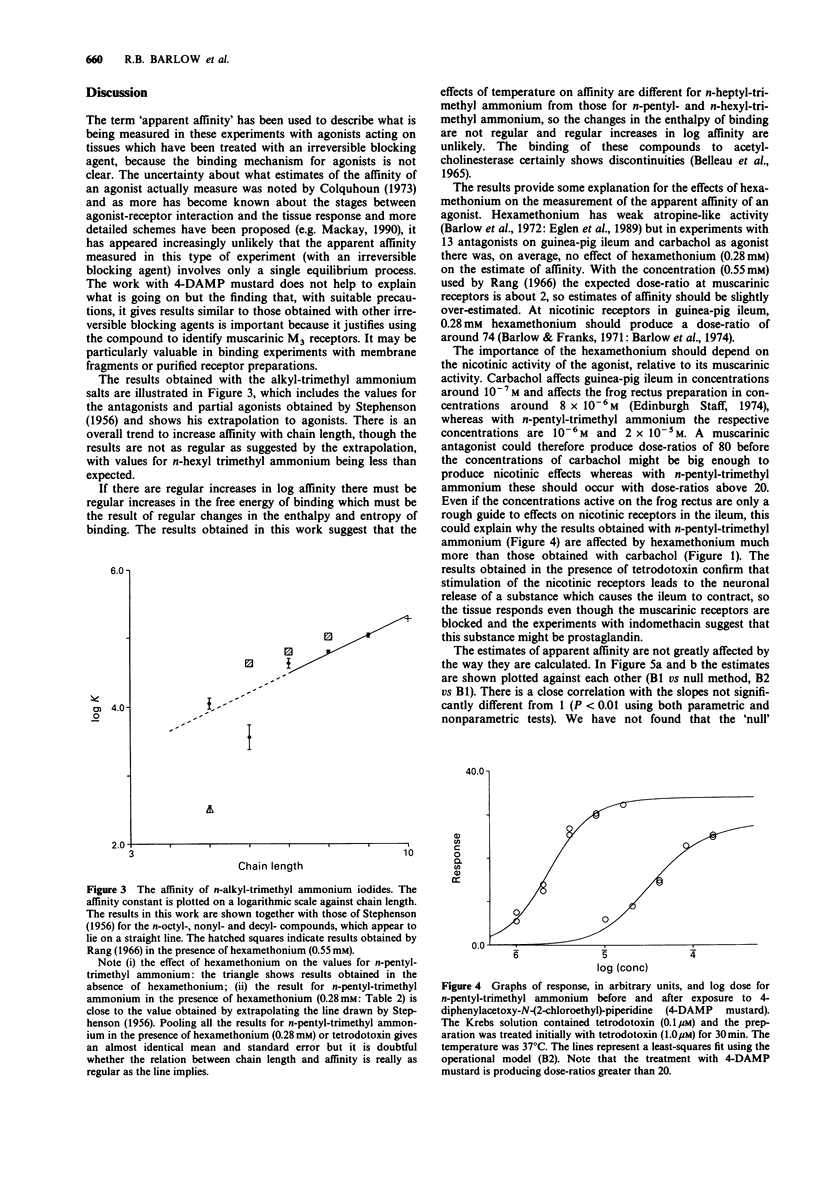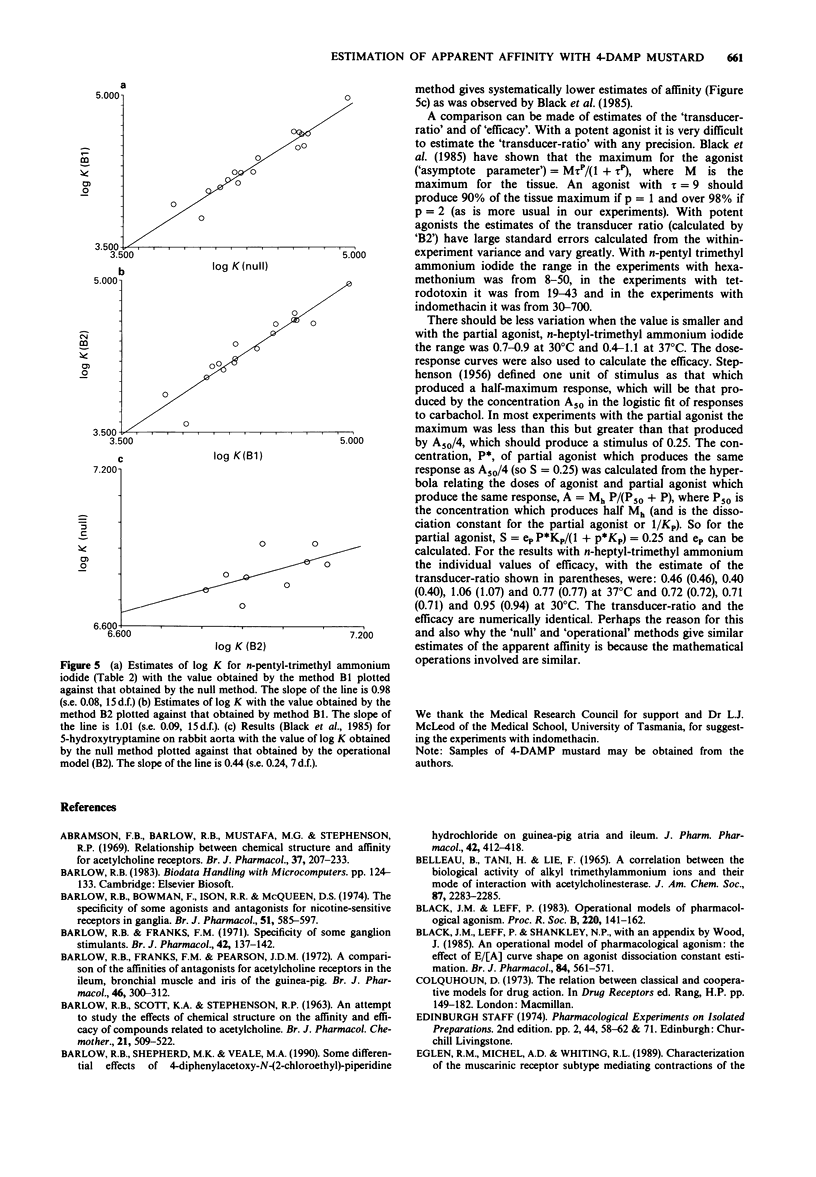Abstract
1. 4-Diphenylacetoxy-N-(2-chloroethyl)-piperidine (4-DAMP mustard), which is known to block muscarinic M3 receptors in preference to muscarinic M2 receptors, was used to estimate the apparent affinity constants of some agonists acting at muscarinic receptors in guinea-pig ileum. Estimates for carbachol and n-pentyl-trimethyl ammonium iodide were similar to published values obtained in similar conditions: those for n-hexyl-trimethyl ammonium iodide were slightly lower. 2. The results for the agonists, n-pentyl- and n-hexyl-trimethyl ammonium iodides and for the partial agonist, n-heptyl-trimethyl ammonium iodide were not as regular as was suggested by Stephenson, though there is an overall increase in apparent affinity with chain length. 3. Estimates of apparent affinity may be affected by hexamethonium, usually present in experiments on ileum. Its absence had little effect on the results with carbachol but reduced the estimates obtained with n-pentyl trimethyl ammonium, which has strong nicotinic effects compared with its muscarinic effects. On ileum treated with tetrodotoxin the values for n-pentyl trimethyl ammonium were similar to those obtained in the presence of hexamethonium (0.28 mM): slightly higher estimates of affinity were obtained in the presence of indomethacin (2.8 microM). The nicotinic effects of n-pentyl ammonium may involve the release of prostaglandins. 4. The estimates of apparent affinity did not depend on the method used to calculate them as the 'null' method and the 'operational' method give similar answers. Estimates of the transducer-ratio for the partial agonist, n-heptyl-trimethyl ammonium iodide, were numerically the same as those of its efficacy.(ABSTRACT TRUNCATED AT 250 WORDS)
Full text
PDF





Selected References
These references are in PubMed. This may not be the complete list of references from this article.
- Abramson F. B., Barlow R. B., Mustafa M. G., Stephenson R. P. Relationships between chemical structure and affinity for acetylcholine receptors. Br J Pharmacol. 1969 Sep;37(1):207–233. doi: 10.1111/j.1476-5381.1969.tb09539.x. [DOI] [PMC free article] [PubMed] [Google Scholar]
- BARLOW R. B., SCOTT K. A., STEPHENSON R. P. AN ATTEMPT TO STUDY THE EFFECTS OF CHEMICAL STRUCTURE ON THE AFFINITY AND EFFICACY OF COMPOUNDS RELATED TO ACETYLCHOLINE. Br J Pharmacol Chemother. 1963 Dec;21:509–522. doi: 10.1111/j.1476-5381.1963.tb02019.x. [DOI] [PMC free article] [PubMed] [Google Scholar]
- BELLEAU B., TANI H., LIE F. A CORRELATION BETWEEN THE BIOLOGICAL ACTIVITY OF ALKYLTRIMETHYLAMMONIUM IONS AND THEIR MODE OF INTERACTION WITH ACETYLCHOLINESTERASE. J Am Chem Soc. 1965 May 20;87:2283–2285. doi: 10.1021/ja01088a033. [DOI] [PubMed] [Google Scholar]
- Barlow R. B., Bowman F., Ison R. R., McQueen D. S. The specificity of some agonists and antagonists for nicotine-sensitive receptors in ganglia. Br J Pharmacol. 1974 Aug;51(4):585–597. doi: 10.1111/j.1476-5381.1974.tb09678.x. [DOI] [PMC free article] [PubMed] [Google Scholar]
- Barlow R. B., Franks F. M., Pearson J. D. A comparison of the affinities of antagonists for acetylcholine receptors in the ileum, bronchial muscle and iris of the guinea-pig. Br J Pharmacol. 1972 Oct;46(2):300–312. doi: 10.1111/j.1476-5381.1972.tb06875.x. [DOI] [PMC free article] [PubMed] [Google Scholar]
- Barlow R. B., Franks F. Specificity of some ganglion stimulants. Br J Pharmacol. 1971 May;42(1):137–142. doi: 10.1111/j.1476-5381.1971.tb07093.x. [DOI] [PMC free article] [PubMed] [Google Scholar]
- Barlow R. B., Shepherd M. K., Veale M. A. Some differential effects of 4-diphenylacetoxy-N-(2-chloroethyl)-piperidine hydrochloride on guinea-pig atria and ileum. J Pharm Pharmacol. 1990 Jun;42(6):412–418. doi: 10.1111/j.2042-7158.1990.tb06581.x. [DOI] [PubMed] [Google Scholar]
- Black J. W., Leff P. Operational models of pharmacological agonism. Proc R Soc Lond B Biol Sci. 1983 Dec 22;220(1219):141–162. doi: 10.1098/rspb.1983.0093. [DOI] [PubMed] [Google Scholar]
- Black J. W., Leff P., Shankley N. P., Wood J. An operational model of pharmacological agonism: the effect of E/[A] curve shape on agonist dissociation constant estimation. Br J Pharmacol. 1985 Feb;84(2):561–571. doi: 10.1111/j.1476-5381.1985.tb12941.x. [DOI] [PMC free article] [PubMed] [Google Scholar]
- Eglen R. M., Michel A. D., Whiting R. L. Characterization of the muscarinic receptor subtype mediating contractions of the guinea-pig uterus. Br J Pharmacol. 1989 Mar;96(3):497–499. doi: 10.1111/j.1476-5381.1989.tb11843.x. [DOI] [PMC free article] [PubMed] [Google Scholar]
- Grana E., Lucchelli A., Zonta F., Boselli C. Determination of dissociation constants and relative efficacies of some potent muscarinic agonists at postjunctional muscarinic receptors. Naunyn Schmiedebergs Arch Pharmacol. 1987 Jan;335(1):8–11. doi: 10.1007/BF00165028. [DOI] [PubMed] [Google Scholar]
- Mackay D. Agonist potency and apparent affinity: interpretation using classical and steady-state ternary-complex models. Trends Pharmacol Sci. 1990 Jan;11(1):17–22. doi: 10.1016/0165-6147(90)90036-8. [DOI] [PubMed] [Google Scholar]
- Parker R. B., Waud D. R. Pharmacological estimation of drug-receptor dissociation constants. Statistical evaluation. I. Agonists. J Pharmacol Exp Ther. 1971 Apr;177(1):1–12. [PubMed] [Google Scholar]
- Rang H. P. The kinetics of action of acetylcholine antagonists in smooth muscle. Proc R Soc Lond B Biol Sci. 1966 Apr 19;164(996):488–510. doi: 10.1098/rspb.1966.0045. [DOI] [PubMed] [Google Scholar]
- STEPHENSON R. P. A modification of receptor theory. Br J Pharmacol Chemother. 1956 Dec;11(4):379–393. doi: 10.1111/j.1476-5381.1956.tb00006.x. [DOI] [PMC free article] [PubMed] [Google Scholar]


